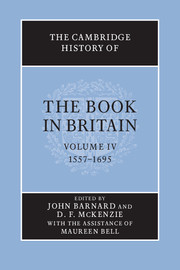Book contents
- Frontmatter
- Dedication
- Contents
- List of illustrations
- List of contributors
- Preface
- Acknowledgements
- Introduction
- RELIGION AND POLITICS
- ORAL TRADITIONS AND SCRIBAL CULTURE
- LITERATURE OF THE LEARNED
- LITERARY CANONS
- VERNACULAR TRADITIONS
- 21 The Bible trade
- 22 English law books and legal publishing
- 23 ABCs, almanacs, ballads, chapbooks, popular piety and textbooks
- 24 Books for daily life: household, husbandry, behaviour
- 25 The creation of the periodical press 1620–1695
- THE BUSINESS OF PRINT AND THE SPACE OF READING
- BEYOND LONDON: PRODUCTION, DISTRIBUTION, RECEPTION
- DISRUPTION AND RESTRUCTURING: THE LATE SEVENTEENTH-CENTURY BOOK TRADE
- STATISTICAL APPENDICES
- Abbreviations
- Bibliography
- Index
- Plate Section
- References
23 - ABCs, almanacs, ballads, chapbooks, popular piety and textbooks
from VERNACULAR TRADITIONS
- Frontmatter
- Dedication
- Contents
- List of illustrations
- List of contributors
- Preface
- Acknowledgements
- Introduction
- RELIGION AND POLITICS
- ORAL TRADITIONS AND SCRIBAL CULTURE
- LITERATURE OF THE LEARNED
- LITERARY CANONS
- VERNACULAR TRADITIONS
- 21 The Bible trade
- 22 English law books and legal publishing
- 23 ABCs, almanacs, ballads, chapbooks, popular piety and textbooks
- 24 Books for daily life: household, husbandry, behaviour
- 25 The creation of the periodical press 1620–1695
- THE BUSINESS OF PRINT AND THE SPACE OF READING
- BEYOND LONDON: PRODUCTION, DISTRIBUTION, RECEPTION
- DISRUPTION AND RESTRUCTURING: THE LATE SEVENTEENTH-CENTURY BOOK TRADE
- STATISTICAL APPENDICES
- Abbreviations
- Bibliography
- Index
- Plate Section
- References
Summary
Works designed and priced for a broad public which included but was not exclusively composed of the poorer and less well-educated and works printed for the education of the young were produced in very large numbers during the sixteenth and seventeenth centuries. Their cheapness, which increased in relation to wages over our period, has meant that their survival rate is in inverse proportion to the quantities produced. Hundreds of thousands of copies of ABCs and primers were printed but few are now extant. Some early single sheet almanacs and Elizabethan ABCs for example have survived only because they were used as part of the bindings of more expensive books. Street ballads and chapbooks exist in larger numbers, since they attracted early and careful collectors. During the last two decades the content and cultural significance and methods of distributing many of these works have received increasing attention, though there are still lacunae in our knowledge of aspects of their production, including editorial, printing and pricing strategies and actual numbers produced.
The growth in literacy which marked our period – and the ability to read simple texts was more widely diffused than writing skills – has been studied in a wide context, including the growth in the number of petty schools and grammar schools, the instruction of girls in reading and writing outside the school system, and the stimulus to reading that cheap and popular print itself provided. The basic printed aids to literacy included the hornbook, the ABC with the catechism, and the primer. The next stage was instruction in Latin, necessary for educational and social advancement and for entry into professional careers.
Keywords
- Type
- Chapter
- Information
- The Cambridge History of the Book in Britain , pp. 504 - 513Publisher: Cambridge University PressPrint publication year: 2002
References
- 4
- Cited by



